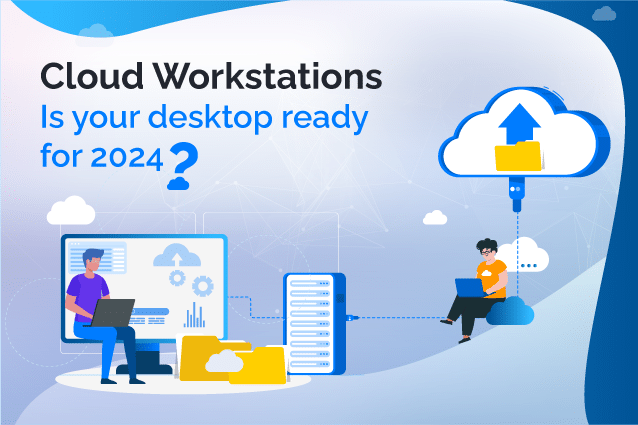
People once believed that coming to the office for work was the only option. Lockdown made a silent message in the other direction, and the entire world saw an increase in remote or hybrid work. However, when your team is dispersed across many locations, how can you keep them secure while remaining productive? And this opened the door for businesses to consider and create technology in ways that promote a safe and easy working environment. Demand drives innovation, and the existence of virtual desktop infrastructure is proof of this.
Let’s go further with their current state of virtual desktops.
Why would work be limited to a single device when entertainment isn’t? Professionals can access their office laptops from any location using these virtual desktops. In modern workplace settings, VDI have earned their unique place because of their security and versatility.
Proof for this can be witnessed in the 2023 market, where virtual desktops were valued at $9.16 billion. Further, it is projected to rise to $11.11 billion in 2025 and reach $51.71 billion by 2032, with an annual growth rate of 21.20%.
Anne Wojciki aptly stated, “The reality is that the only way change comes is when you lead by example”. Similarly, let’s move forward with the trends shaping Virtual Desktops:
Infographics
As remote work becomes more common, security is a significant consideration while implementing Virtual Desktop Infrastructure (VDI). It provides multi-layered defence along Multi-Factor Authentication (MFA), and Data Encryption.
AI improves virtual desktops by optimizing user interfaces and automating processes. It frees up IT employees to concentrate on more strategic responsibilities by automating monotonous chores such as provisioning along with patching virtual machines and optimizing workflows. Also, AI-driven virtual assistants greatly enhance the remote work environment by configuring desktops for specific users and aiding in real time.
Virtual desktops integrated with edge computing are becoming increasingly popular. Through processing data close to users, edge computing minimizes latency and improves overall performance in high bandwidth applications. Because it provides a steady virtual desktop experience regardless of internet fluctuations, this integration is especially helpful for users with erratic internet connectivity.
Desktop-as-a-Service (DaaS) is replacing virtual desktop delivery in a big way. With DaaS, the complete virtual desktop architecture is managed by a cloud provider through a subscription-based model. Such a managed approach eliminates the requirement for internal IT expertise within businesses, which lowers upfront costs and streamlines the implementation of virtual desktops.
In 2025, the rise of VDI is redefining how businesses manage a wide range of workloads, from ordinary desktop apps to high-demand jobs. Thanks to this development, people now can effectively access and use advanced software tools without depending on expensive personal gear. VDI improves user experience across a range of computing needs and improves operational efficiency via centralized processing and resource allocation. By streamlining processes and reducing the need for large hardware purchases, this tactical strategy improves computing affordability and accessibility for all users.
Advancements like robust security, AI integration, and the growth of Desktop-as-a-Service (DaaS) appear to portend a bright future for virtual desktop infrastructure (VDI). Still, this is not all there is. Even more intriguing possibilities for the future.
VDI is on the verge of moving beyond conventional desktop environments. It opens new possibilities as a foundation for Augmented Reality (AR) and Virtual Reality (VR) experiences. This integration might allow engineers to play with 3D models immediately within their virtual desktops, for example, or to create immersive training simulations. Such improvements have the potential to open a variety of creative uses across a broad spectrum of industries.
Artificial intelligence (AI) serves to customize and improve the VDI experience. AI can assess user patterns and preferences in order and then populate virtual desktops with the appropriate applications, layouts, and settings. This user-centric strategy makes sure the workspace is adapted to the individual’s needs. Furthermore, AI can optimize resource distribution according to real-time usage patterns, ensuring an easy and effective journey for all users.
VDI companies have shifted their focus to improve the user experience. This strategy results in simple interfaces, quick application access, and effortless integration with collaborative tools. Real-time document co-editing, shared workspaces, along with integrated video conferencing are becoming prevalent features in VDI setups. This encourages collaboration in the workplace, allowing teams that are scattered to work efficiently together.
Although VDI doesn’t automate processes swiftly, it does create an environment that is favorable to the effective use of automation technologies. VDI’s centralized management and standardization of the environment guarantee uniform desktop setups, which makes the creation and implementation of automation scripts easier. Furthermore, task automation becomes less risky with VDI due to its inherent security. The benefits of automation then become even more apparent, such as improved resource allocation and quicker procedures for software updates, data backups, and user onboarding, all of which improve productivity and security at work.
Following the rise of remote and hybrid work modes, Virtual Desktop Infrastructure (VDI) has grown as a powerful option for the modern work environment. VDI provides a dynamic and secure environment, allowing professionals to work efficiently from anywhere. The VDI industry is expanding, with forecasts of more than $51 billion by 2032. This expansion is driven by ongoing developments that fulfill user needs.
Looking into the future, VDI has an exciting prospect full of intriguing opportunities. Integration with AR/VR technology can transform industries such as engineering and training. AI-powered personalization will result in custom-fit workspaces that improve user experience. Collaboration tools will become fully integrated, encouraging teamwork regardless of location.
To summarize, virtual desktops are more than simply a trend; they represent the future of work. As technology advances, VDI systems will get increasingly sophisticated, secure, and user centric. Businesses that embrace virtual desktops may empower their workforce, create a collaborative environment, and manage the perpetually shifting workplace with agility and profitability.